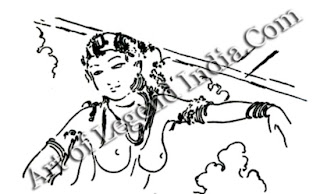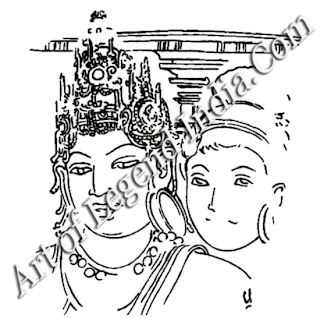 The
ceiling of the cave contains a picture of a magnificent lake with beautiful
buffaloes, geese and fish frolicking amidst lotuses in bud and bloom, in the
gathering of which some youths are shown engaged. The figures are drawn with
great care and delicacy of feeling. The most magnificent of the paintings,
however, are the king wearing a lovely crown and accompanied by his queen, with
an umbrella raised over both, and two female dancers of exquisite grace and
proportions, all presented on the cubical parts of the pillars of the mandapa.
Much of this has been ruined by weather and vandalism. There is still enough
left to help us judge the skill of the painter during the early phase of
Pandyan rule. The coiffure of the dancers, the lines composing the face, the
contour of the body in beautiful flexions, the attitude of the hands in
rhythmic dance motion is the work of a great master. The grace of the crown
with minute details of workmanship and the dignity of the royal figure in the
company of his consort cannot be praised too highly.
The
ceiling of the cave contains a picture of a magnificent lake with beautiful
buffaloes, geese and fish frolicking amidst lotuses in bud and bloom, in the
gathering of which some youths are shown engaged. The figures are drawn with
great care and delicacy of feeling. The most magnificent of the paintings,
however, are the king wearing a lovely crown and accompanied by his queen, with
an umbrella raised over both, and two female dancers of exquisite grace and
proportions, all presented on the cubical parts of the pillars of the mandapa.
Much of this has been ruined by weather and vandalism. There is still enough
left to help us judge the skill of the painter during the early phase of
Pandyan rule. The coiffure of the dancers, the lines composing the face, the
contour of the body in beautiful flexions, the attitude of the hands in
rhythmic dance motion is the work of a great master. The grace of the crown
with minute details of workmanship and the dignity of the royal figure in the
company of his consort cannot be praised too highly.Introduction to Early Pandya, Seventh to Ninth Century A.D.
Posted by
Art Of Legend India [dot] Com
On
10:24 PM
Like
the Pallava king Mahendravarman, who was converted by Appar, the older
contemporary of Tirujnanasam-bandar, Arikesari Parankusa, the Pandyan king, was
re-claimed from Jainism by the saint, Tirujnanasam-bandar, in the latter half
of the seventh century A. D. This king with the zeal of a new convert and with
the enthusiastic support of his queen advanced his faith.
During
the time of Simhavishnu, who overcame the Pandyas, his son Mahendravarman and
grandson Narasimhavarman, who dominated in the South during his time, as the
vanquisher of even Pulakesin of the Western Chalukya dynasty, Pallava influence
was dominant in the South. The Pandya king Maravarman Rajasimha, also known as
Pallavabhanjana, found it a favourable moment to attack the Pallavas during the
time of Nandivarman Pallavamalla. His son Nedunjadayan had a minister
uttarantantri Marangari alias Madhurakavi, who excavated a temple for Vishnu in
the Annamalai hill in the neighbor-hood of Madurai and recorded it in an
inscription. It is this history of the early Pandyas which should help us
under-stand why both the cave temples and the rock-cut free standing temples of
the Pandyas so closely resemble and recall those of the early Pallavas.
The
Pandyas, like the Chalukyas, were frequently fighting the Pallavas, but
nevertheless were struck with the beauty of the Pallava cave temples and
monolithic shrines.
They
had also a matrimonial alliance with the Pallavas as in the case of Kochchadayan,
the father of Maravarman Rajasimha, and the aesthetic taste of a princess of
the Pallava line would not have gone without self-expression, specially when we
remember that Rangapataka, the queen of Pallava Rajasimha, associated herself
with her husband in the construction of lovely temples at Kanchipuram, and this
artistic taste was inborn in their family. It is no wonder therefore that,
considering the proximity of the Pallava country, with the Chera power
practically eclipsed at the time, the Pandyas adopted the ideas of the Pallavas
in architecture, sculpture and painting.
In the
Tirumalaipuram cave temple, there are fragments discovered by Professor Jouveau
Dubreuil to show specimens of the painter's art in the early Pandyan period.
The cave closely resembles the Pallava caves of Mahendravarman. Though most of
the paintings here are obliterated, the few that remain show the dexterity of
the painter in portraying such themes as the swan or the duck and lotuses in
bud and bloom in pleasing patterns covering the ceiling and on the pillar
brackets.
There
are also themes like hunters and their wives, one of whom is shown carrying a
wild boar after a hunt. This theme of bacchanalian orgies suggests traces of
foreign influence, which is explained by the fact that the Pandyan kingdom was
a rich commercial centre, with contacts all over the civilised world, specially
with Rome, from the early centuries of the Christian era. The pearls of the
Pandyan fisheries were greatly in demand in Rome and a regular colony of
Yavanas existed at Madurai.
To
Professor Jouveau Dubreuil, we owe the discovery of paintings similar to those
at Ajanta in Sittannavasal. These are in the best tradition of classical art
and were originally believed to be Pallava. It is now found that there are two
layers of paintings, an earlier one and a later one, as also an inscription which
proves that what were originally reckoned Pallava are really Pandyan paintings
of the ninth century A.D.
 The
ceiling of the cave contains a picture of a magnificent lake with beautiful
buffaloes, geese and fish frolicking amidst lotuses in bud and bloom, in the
gathering of which some youths are shown engaged. The figures are drawn with
great care and delicacy of feeling. The most magnificent of the paintings,
however, are the king wearing a lovely crown and accompanied by his queen, with
an umbrella raised over both, and two female dancers of exquisite grace and
proportions, all presented on the cubical parts of the pillars of the mandapa.
Much of this has been ruined by weather and vandalism. There is still enough
left to help us judge the skill of the painter during the early phase of
Pandyan rule. The coiffure of the dancers, the lines composing the face, the
contour of the body in beautiful flexions, the attitude of the hands in
rhythmic dance motion is the work of a great master. The grace of the crown
with minute details of workmanship and the dignity of the royal figure in the
company of his consort cannot be praised too highly.
The
ceiling of the cave contains a picture of a magnificent lake with beautiful
buffaloes, geese and fish frolicking amidst lotuses in bud and bloom, in the
gathering of which some youths are shown engaged. The figures are drawn with
great care and delicacy of feeling. The most magnificent of the paintings,
however, are the king wearing a lovely crown and accompanied by his queen, with
an umbrella raised over both, and two female dancers of exquisite grace and
proportions, all presented on the cubical parts of the pillars of the mandapa.
Much of this has been ruined by weather and vandalism. There is still enough
left to help us judge the skill of the painter during the early phase of
Pandyan rule. The coiffure of the dancers, the lines composing the face, the
contour of the body in beautiful flexions, the attitude of the hands in
rhythmic dance motion is the work of a great master. The grace of the crown
with minute details of workmanship and the dignity of the royal figure in the
company of his consort cannot be praised too highly.
Writer – C. Shivaramamurti
Subscribe to:
Post Comments (Atom)












0 Response to "Introduction to Early Pandya, Seventh to Ninth Century A.D. "
Post a Comment